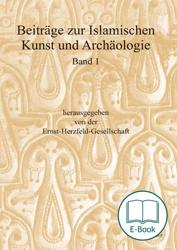Volume 1 of the „Contributions to Islamic Art History and Archaeology“ presents a part of the papers from the first two colloquies of the Ernst Herzfeld-Society, 2005 and 2006. They include research based on fieldwork and work relating to art history, epigraphy, and literature. The chronological scope reaches from the early Islamic to the modern period, the geographical range from Andalusia as far as China.
Volume 1 of the „Contributions to Islamic Art History and Archaeology“ presents in two sections a part of the papers that were read in the First and the Second Colloquy of the Ernst Herzfeld-Society, in Bamberg, July 2005 and in Bonn, July 2006 respectively.
The contributions in both sections show the variety of themes and the geographical range of art historical and archaeological research that is envisaged by publications of the Society. They include research based on fieldwork and relating to art and architectural history, epigraphy and literature. In chronological scope, they reach from the early Islamic to the modern period including glimpses on 19th-20th-century repercussions of historical forms of Islamic art. The geographical range stretches from the Iberian Peninsula as far as China. The subjects relate to objects and monuments from the cultures of Western and Central Asia as well as to archaeological finds taken to Western museums and architectural forms adopted by European eclecticism. Last but not least, Volume 1 as the inauguration volume of a series edited by the Society, includes also biographical studies on the work and artistic talent of its patron of name, Ernst Herzfeld.
The section relating to the First Colloquy includes papers on finds made by Herzfeld in Samarra, epigraphy from a mosque in China, Indian architecture from Delhi, and new findings on architecture in Spain and from excavations in Syria. The reader learns about orientalizing architecture of the Bavarian King Ludwig II, the use of decorative forms taken from Islamic art, and objects in German collections. The section relating to the Second Colloquy introduces recent research in Spain and provides contributions on architecture in India and Central Asia. An essay tackles the adoption of aesthetics of Islamic art in 19th-century European art.
It is an important aspect of this series, that it offers an adequate fore also to younger scholars from disciplines concerned with the art history, the architecture and the archaeology of the Islamic world. Moreover, it is a fore that allows different languages as just another way of furthering an international exchange of research on Islamic culture, which is pursued along different traditions in the countries of Europe.
„Zur Erforschung der Vielfalt solcher Traditionslinien und Verknüpfungen erscheinen Interdisziplinarität und Internationalität als wichtige Maßgaben. Dahingehend ist die vom Band erreichte Multidisziplinarität als ein Statement hinsichtlich der Offenheit der von der Gesellschaft vertretenen Sichtweise des Islam zu verstehen, womit sie auch ihrem Namenspatron Ernst Herzfeld durchaus gerecht
wird. Wie bereits im dritten Band der Reihe eingelöst, erscheint es jedoch empfehlenswert, auch den hoffentlich zahlreichen weiteren Tagungsbänden ein klares thematisches oder theoretisches Profil zu verleihen. Zudem wäre es hinsichtlich der Internationalität wünschenswert, wenn die Artikel von einer Zusammenfassung in englischer Sprache begleitet würden.“
Von Alberto Saviello, Berlin
In: Orientalistische Literaturzeitung 108 (2013) 4-5, S. 299-301.
The aim of the Ernst Herzfeld Society is an adequate edition of all papers presented at the colloquia and other articles of academic value.


 Table of Contents
Table of Contents